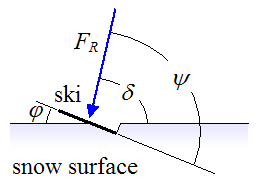| Image from: uk.eurosport.yahoo.com Credit: Reuters |
It was evident that we have energy transformation (from potential to kinetics):
"As the skier begins the descent down the hill, potential energy is lost and kinetic energy (i.e., energy of motion) is gained. As the skier loses height (and thus loses potential energy), she gains speed (and thus gains kinetic energy). Once the skier reaches the bottom of the hill, her height reaches a value of 0 meters, indicating a total depletion of her potential energy. At this point, her speed and kinetic energy have reached a maximum. This energy state is maintained until the skier meets a section of unpacked snow and skids to a stop under the force of friction. The friction force, sometimes known as a dissipative force, does work upon the skier in order to decrease her total mechanical energy. Thus, as the force of friction acts over an increasing distance, the quantity of work increases and the mechanical energy of the skier is gradually dissipated. Ultimately, the skier runs out of energy and comes to a rest position. Work done by an external force (friction) has served to change the total mechanical energy of the skier." (in Physics Classroom)The NSF has a great video about this topic:
I found that all the materials must be design to support bumps and torsion:
"Ski materials have received an equally extensive makeover. Engineers are continually working to make skis lighter and more flexible to absorb bumps in the snow, while keeping them rigid enough to hold their shape during turns. For that reason, metal skis were introduced in the 1950s. Today’s skis, because of their broader tips and tails, have to endure torsional forces that skis of the past could not have withstood. Most skis are now made of sandwiches of fiberglass, wood, aluminum alloys, glue, and polymers." (in Discover Magazine)
They running with a crouch position to reduce drag force:
"A skier maximizes his speed by minimizing resistance to motion, both from air resistance and snow resistance. A skier minimizes his air resistance (drag) by reducing his projected frontal area. He does this by going into a crouch position, which (along with improving his ability to hold balance) results in a lower drag force, which acts in a direction opposite his velocity, slowing him down. The picture below shows a downhill skier in a crouch position." (in Real World Physics Problems)
And they have curved skies to prevent slipping on snow:

"To prevent slipping, the angle ψ must be greater than or equal to 90° . This means that the component of FR parallel to the plane of the ski, will either be zero (for ψ = 90°), or it will point directly into the snow, towards the right (for ψ > 90°), and the "wall" of snow will prevent it from slipping." (in Real World Physics Problems)
What a great sport!


No comments:
Post a Comment